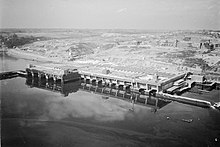The fortress (Buchheim)
The fortress is the title of a novel by Lothar-Günther Buchheim , which was published in 1995 by Hoffmann und Campe . It is a sequel to his book Das Boot , which was published in 1973.
The novel describes the author's experiences as a naval war correspondent during the Second World War in the period shortly before and after the Allied invasion of France in the summer of 1944.
content
The reader accompanies Buchheim on his odyssey through a Europe destroyed by war. The story begins with the arrival of U 96 in Saint-Nazaire after the war correspondent Buchheim's second patrol on the boat. Here he learns that a marching order to Berlin is waiting for him, where he should report to Propaganda Minister Joseph Goebbels . In addition to himself, Heinrich Lehmann-Willenbrock , known as “the old man”, had to leave the boat until then, because he was appointed commander of the 9th submarine flotilla in Brest . In Berlin, Buchheim awaits the news that his publisher Peter Suhrkamp has been arrested by the Gestapo after a denunciation . Buchheim's experience report on the submarine war, "Hunters in the Ocean" , receives official approval and is supposed to appear despite the acute shortage of paper. The commission to immortalize Grand Admiral Karl Dönitz and his submarine aces in a painting brought him a short, almost idyllic stay as a war painter in his adopted home Feldafing , but before it was carried out he was sent back to France via Berlin.
He witnessed the beginning of the invasion in Paris ; from there he is ordered to the invasion front. Buchheim is shocked to see the hopeless inferiority of the German troops; he knows that ultimate defeat is only a matter of time. Instead of embarking on a suicide mission on a speedboat , as ordered, he went to Brest on the pretext of a command that was still issued in Berlin. There he is subordinate to the "old man" whom he has already accompanied on patrols in the Atlantic. He learns from the old man that his former lover Simone Sagot was kidnapped by the SD . Buchheim experiences how submarines have to return unsuccessfully only a few days after leaving the base, damaged by aircraft attacks, how more and more boats are reported as missing and, after July 20, 1944, ever stricter measures are taken against anyone who wins Expresses doubt.
While American associations have already cut off Brest, another submarine is entering the port, which also narrowly escaped a hopeless enterprise. The leadership orders the boat to the not yet cut off La Pallice on the southern French Atlantic coast, where a number of naval administrators are to take it; Buchheim is sent along by the old man. Buchheim escapes the Brest trap in a dramatic trip with the U 730, which is manned to the breaking point and with the help of a snorkel almost exclusively underwater. From La Pallice he makes his way through France via Paris, where he wants to find Simone, to the German border in a car with a creeping wood carburetor drive , affectionately known by Buchheim as the “Arche”. He is accompanied by an all too talkative aging senior boatman and a taciturn driver. The small troop barely escapes the rapidly advancing allies. When he arrived in Paris, he missed Simone's deportation to the Ravensbrück concentration camp by a few days, but thought he recognized her a short time later in a massacre at a railroad crossing. Nevertheless their track is lost. On the way through occupied France, he clearly sees the dissolution and flight of the German troops and is wounded in an air raid.
When they arrived in Alsace, Buchheim in Saverne provided the staff of the Marine Group Command West who had fled there . The story ends when he turns his MP against the management staff present and collapses.
layout
Simone Sagot plays Buchheim's future wife Gwen Militon.
literature
- Lothar Günther Buchheim: The fortress . Hoffmann and Campe , Hamburg, 1996. ISBN 978-3-455-00733-6 (first edition).
Web links
- Killed, the poor pigs Report on the creation in: Der Spiegel from April 17, 1995
